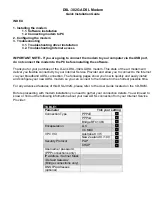
DART 200 CDPD Modem User’s Guide
5 DART Supported Protocols
PN1197-00 Revision 1.0
5-17
4.
Once the data block is received it is ready for processing. Any
necessary error-checking, resequencing, and so on, is handled by the
TCP software and is not the responsibility of the MAS. The handling
of network connectivity issues (such as loss of carrier), as opposed to
data delivery and sequencing (provided by TCP), is the responsibility
of the MAS. Refer to
Error recovery,
p. 8-4, for guidelines on error
handling.
5.
Once the first data block has been received, the server system (MAS
or central site depending on application design) could reply to the
client system with data of its own, or it could wait for additional data
from the client. The variations at this point are numerous and entirely
dependent on application design.
6.
When data transfer is complete the session terminates. As with the
initial communication step, either end could terminate; it is another
application design decision, but usually, the client terminates.
7.
If the MAS is the server, it receives a NO CARRIER message and
returns to command mode when the client terminates the session. If
the MAS is the client, it performs an escape function to return to
command mode followed by a hang-up command (
H
). Refer to
Appendix F,
DART AT Command Set,
for a description of
H
.
Setup options
The following items must be set to enable the DART 200 to operate on
the CDPD network:
•
IP Address (
^A
)
•
Side Preference -
\N
in the modem profile
•
Channel restrictions -
\J
in the modem profile
Refer to
Basic modem personalization,
p. 2-6, for a review of the details
on the AT commands
^A, \N,
and
\J.
In addition the following items are required for basic TCP operation:
•
Automatic registration. Refer to p. 8-6 for details
•
PAD mode -
\O0
in the profile. Refer to
\O
command in Appendix F,
DART AT Command Set
If application design dictates that the MAS accepts connection requests,
activate the TCP server by setting the
*A
(select server type) AT
command to 1 with an
AT*A1
.
Selecting this option enables the TCP
server function. The default value for this parameter is
*A0
(no server
active). The default option is appropriate if the MAS application always
operates in client mode; always originates the connection request with an
ATDT
command.
Summary of Contents for DART 200
Page 4: ...DART 200 CDPD Modem User s Guide Sierra Wireless Inc iv...
Page 18: ...DART 200 CDPD Modem User s Guide About This Guide Sierra Wireless Inc xviii...
Page 50: ...DART 200 CDPD Modem User s Guide 3 CPDP Security Features Sierra Wireless Inc 3 4...
Page 86: ...DART 200 CDPD Modem User s Guide 5 DART Supported Protocols Sierra Wireless Inc 5 32...
Page 90: ...DART 200 CDPD Modem User s Guide 6 Device Attachment Sierra Wireless Inc 6 4...
Page 94: ...DART 200 CDPD Modem User s Guide 7 Vehicle Installation Considerations Sierra Wireless Inc 7 4...
Page 120: ...DART 200 CDPD Modem User s Guide 8 Application Programming Sierra Wireless Inc 8 26...
Page 130: ...DART 200 CDPD Modem User s Guide D SLIP Setup Examples Sierra Wireless Inc D 4...
Page 144: ...DART 200 CDPD Modem User s Guide E S Registers Sierra Wireless Inc E 14...
Page 169: ...DART 200 CDPD Modem User s Guide F DART AT Command Set PN1197 00 Revision 1 0 F 25...
Page 176: ......
Page 180: ...DART 200 CDPD Modem User s Guide H Problem Sheet Sierra Wireless Inc H 2...
Page 202: ...DART 200 CDPD Modem User s Guide Index Sierra Wireless Inc Index 10...
















































